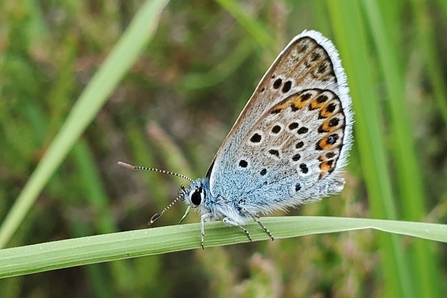This charismatic little butterfly is a lowland heathland specialist and as such is mainly found in southern England, the New Forest being a hot spot, with distributed colonies in East Anglia and Wales. The adults only live for 4 to 5 days, emerging in July and August, so there’s a rush on to find a mate. Consequently, if you can find them, you could witness a shimmering display of silvery blue flittering across the heathland heather, especially in late evening when they congregate to roost. Very similar in appearance to the common blue butterflies, they can be differentiated by the silver ‘studs’ at the edge of the hind wings.
Searching for silver on an English heathland

Silver- studded Blue © Helen Gillooly
I’ve always been fascinated by the blue butterflies which have a lifecycle dependant on a mutualistic relationship with ants. The silver-studded blue in particular is highly reliant on the ants, with females only laying eggs near to where they can detect suitable ant pheromones. Once hatched, the caterpillars are taken into the ant nest where they are kept free from parasites and protected from predators. In return, the caterpillars produce a sugar secretion which the ants use as a food source.
Identifying presence of this species is essential to guide habitat management of the site, which must balance the requirements of the butterfly larvae, adults, and the ants. Pioneer stage (0-6 years old) heather which consists of bare soil and short vegetation is needed for the ants and caterpillars. The adults need nectar sources provided by building stage heathers (7 – 15 years old) as well as roosting sites provided by long grass or mature heather and gorse. This combination of specialised requirements, coupled with the reduction in the amount of lowland heath due to development and agriculture, has resulted in the dramatic decline of the species. Subsequently, they are on the NERC (Natural Environmental and Rural Communities) Act 2006 list of species of conservation concern and are a priority species in the UK’s Biodiversity Action Plan (BAP).
I got the opportunity to undertake a butterfly survey at a site of special scientific interest (SSSI) near Farnborough containing around 11 hectares of dry heathland. The weather conditions were not perfect for surveying but I was hopeful and had my fingers crossed that I might find silver-studded blue butterflies there. Nearing the end of the survey with no sightings, my hope was starting to wane but then I saw a silvery blue flash dash across in front of me and rest on some grass. A close inspection of the wings and yes, it was a silver-studded blue. I saw 7 in total, what an amazing experience.
Helen Gillooly
Trainee Ecologist

